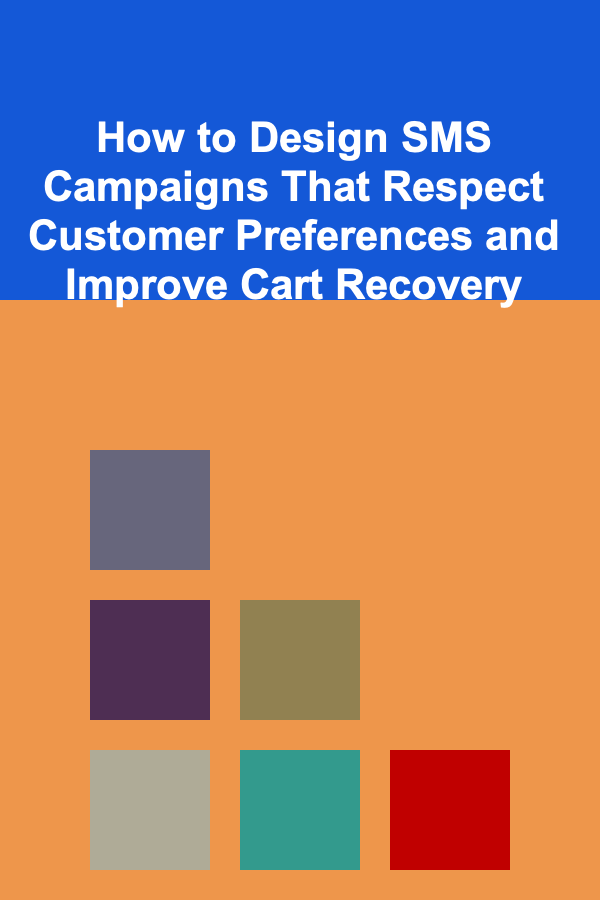
How to Design SMS Campaigns That Respect Customer Preferences and Improve Cart Recovery
ebook include PDF & Audio bundle (Micro Guide)
$12.99$6.99
Limited Time Offer! Order within the next:

In today's eCommerce world, SMS marketing has become a powerful tool for businesses looking to recover abandoned shopping carts and increase conversion rates. When done right, SMS campaigns can drive significant engagement and revenue, but they must be designed carefully to respect customer preferences and provide value.
This actionable guide will walk you through the process of designing SMS campaigns that not only improve cart recovery but also foster trust and respect with your customers. We'll cover best practices, actionable strategies, and key insights to help you create effective, customer-centric SMS campaigns.
Understand the Role of SMS in Cart Recovery
Before diving into designing SMS campaigns, it's essential to understand the role SMS plays in cart recovery. Cart abandonment is a common challenge in eCommerce, with many customers leaving their shopping carts behind before completing the purchase. Factors like distractions, unexpected costs, or second thoughts can cause potential customers to abandon their carts.
SMS marketing offers a direct and immediate way to re-engage these customers. Since SMS messages have high open rates (around 98%) and are read within minutes of receipt, they present a unique opportunity to recover abandoned carts. However, the key to success is ensuring that your SMS campaigns are respectful of your customer's time, preferences, and privacy.
Gather Customer Preferences and Consent
The first step in designing an SMS campaign that respects customer preferences is obtaining clear consent from your customers. Sending SMS messages without proper opt-in can violate privacy regulations (like GDPR or TCPA) and damage your brand's reputation.
How to Obtain Consent:
- Use a Clear Opt-In Process: Ensure customers explicitly agree to receive SMS messages. A simple checkbox during checkout or account creation works well.
- Provide Value in Exchange for Consent: Customers are more likely to opt in if they understand the benefits. Offer incentives like discounts or exclusive offers in exchange for their consent to receive SMS marketing.
- Be Transparent About Frequency: Inform customers about how often they will receive messages. Being upfront about the frequency helps set the right expectations and reduces the risk of opt-outs.
- Respect Opt-Out Requests: Make it easy for customers to opt out of receiving SMS messages. Provide clear instructions (e.g., "Reply STOP to unsubscribe") in every message.
Segment Your Audience:
Not all customers are the same, and your SMS campaigns should reflect that. Segmenting your audience based on their behavior, purchase history, and preferences ensures that your messages are highly relevant and personalized.
Examples of Segmentation Criteria:
- Cart Abandonment: Send messages to customers who have added items to their cart but haven't checked out.
- Product Interest: Segment customers who've shown interest in specific products but haven't yet purchased them.
- Previous Purchases: Reach out to customers based on their past purchases, offering related products or restocks.
- Engagement Level: Segment based on how often customers engage with your brand---whether they're frequent buyers or occasional shoppers.
By respecting these preferences and tailoring your messages accordingly, you create a more customer-centric approach that increases the likelihood of cart recovery.
Craft Personalized and Compelling SMS Messages
Personalization is a powerful tool in SMS marketing. When you send a personalized message, customers are more likely to engage and complete their purchase. By leveraging customer data, you can craft messages that speak directly to their needs and preferences.
Key Elements of a Personalized SMS:
- Personalize with Name: Always address customers by their first name. A simple "Hi [Customer Name]" goes a long way in making the message feel more personal and genuine.
- Tailor Content to the Cart : Refer directly to the products in the abandoned cart. Instead of sending a generic reminder, tell them exactly what's waiting for them.
- Example: "Hi [Customer Name], your [product name] is still waiting for you. Complete your order now and enjoy 10% off with code CART10!"
- Offer Incentives : Provide a limited-time discount or exclusive offer to encourage them to complete the purchase.
- Example: "Hey [Customer Name], we've saved your cart for you! Use code FINISH20 to get 20% off your order, but hurry---offer expires in 24 hours!"
- Create Urgency : Use urgency to prompt immediate action, but do so in a respectful manner.
- Example: "Don't miss out on your [product name]! Only a few left in stock, so grab yours now before it's gone!"
Keep the Message Concise:
SMS messages are short by nature (160 characters), so keep your copy clear and to the point. Focus on the key action you want your customer to take---whether it's completing the purchase, applying a discount, or simply visiting the website.
Use Clear Calls to Action (CTA):
Always include a clear CTA, guiding the customer on what to do next. Whether it's "Complete Your Purchase," "Shop Now," or "Claim Your Discount," make sure the CTA is specific, actionable, and easy to follow.
Timing is Crucial
Timing is one of the most important factors in an SMS campaign's success. If you send a message too soon after the cart is abandoned, it might feel intrusive. On the other hand, waiting too long may cause the customer to forget about their cart or lose interest.
Best Practices for Timing:
- Send the First SMS Within 1 Hour : Studies have shown that sending an SMS within the first hour of abandonment leads to higher conversion rates. You can send a reminder within this window and gently encourage the customer to complete their purchase.
- Example: "Hey [Customer Name], noticed you left something behind! Your cart is waiting for you. Finish your order and get 10% off now!"
- Send a Follow-Up SMS Within 24 Hours : If the customer hasn't completed the purchase after the first SMS, send a follow-up message within 24 hours. You can remind them of the offer or include additional incentives like free shipping.
- Example: "Hi [Customer Name], still thinking it over? Complete your purchase in the next 24 hours and get FREE shipping!"
- Send a Final SMS Reminder After 48-72 Hours: If the cart is still abandoned, send a final reminder message. By this time, the customer is likely to either have lost interest or decided not to purchase. A final nudge may be what it takes to close the sale.
Use A/B Testing to Optimize SMS Campaigns
Even the best-designed SMS campaigns can benefit from continuous improvement. A/B testing allows you to experiment with different messages, offers, and timings to understand what works best for your audience.
What to Test:
- Message Copy: Experiment with different types of messaging---urgent vs. casual, discounts vs. product highlights, or various CTAs.
- Timing: Test different send times to see when your audience is most responsive. Try sending messages at different times of the day or different days of the week.
- Offer Types: Test various incentive structures, such as percentage-off discounts, dollar-off discounts, or free shipping.
Use the results of your A/B tests to refine your campaigns, ensuring that you're sending the most effective messages at the right times to the right customers.
Ensure a Seamless Checkout Experience
Even with the best SMS campaigns, if your checkout process is clunky or difficult to navigate, your cart recovery efforts will fall flat. It's essential to ensure a smooth and user-friendly checkout experience for your customers.
Simplify the Checkout Process:
- Reduce Form Fields: Minimize the number of steps it takes to complete a purchase. Use autofill options where possible to make the process faster.
- Offer Multiple Payment Options: Ensure that customers can use their preferred payment methods (credit card, PayPal, Apple Pay, etc.).
- Show Clear Shipping and Payment Information: Transparency about shipping costs, delivery dates, and payment options reduces hesitation during checkout.
The easier you make it for customers to complete their purchases, the higher your conversion rates will be.
Measure and Analyze Your Campaign's Effectiveness
To continuously improve your SMS campaigns, it's crucial to measure key performance metrics. By analyzing data, you can understand which campaigns are working, which aren't, and where there's room for improvement.
Key Metrics to Track:
- Delivery Rate: Ensure your messages are being delivered to the right audience.
- Open Rate: Monitor how many recipients open the SMS messages you send.
- Click-Through Rate (CTR): Track how many customers click on the link in your SMS to complete the purchase.
- Conversion Rate: Measure how many abandoned carts are successfully recovered and converted into sales.
- Unsubscribe Rate: Pay attention to the number of opt-outs after each campaign. A high unsubscribe rate may indicate that your messages are too frequent or intrusive.
Use these metrics to refine your strategies and continuously improve the effectiveness of your SMS campaigns.
Conclusion
Designing SMS campaigns that respect customer preferences and improve cart recovery requires a strategic and customer-first approach. By obtaining proper consent, personalizing your messages, optimizing timing, and respecting the checkout experience, you can create effective SMS campaigns that engage your audience without alienating them.
By consistently testing, measuring, and adjusting your approach, you'll be well on your way to increasing cart recovery and boosting your eCommerce sales while building a respectful and trustworthy relationship with your customers.
Other Products

Healthy Eating Habits for Busy Dads: A Comprehensive Guide
Read More
How to Check for Safety and Security in an Apartment
Read More
How to Incorporate Vintage Holiday Decor into Modern Spaces
Read More
How to Make a Checklist for Bookkeeping for Non-Profit Organizations
Read More
How to Set Realistic Financial Goals for Investment
Read More